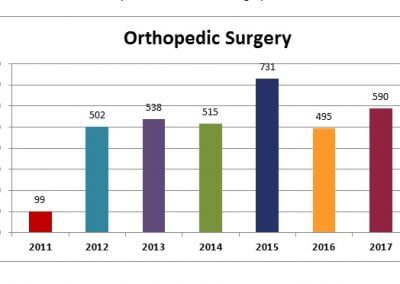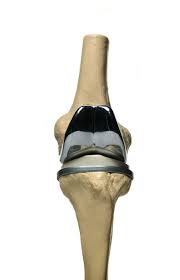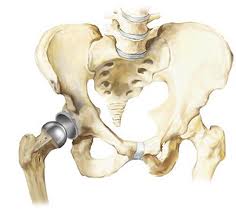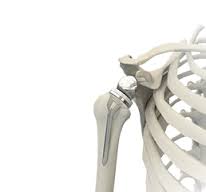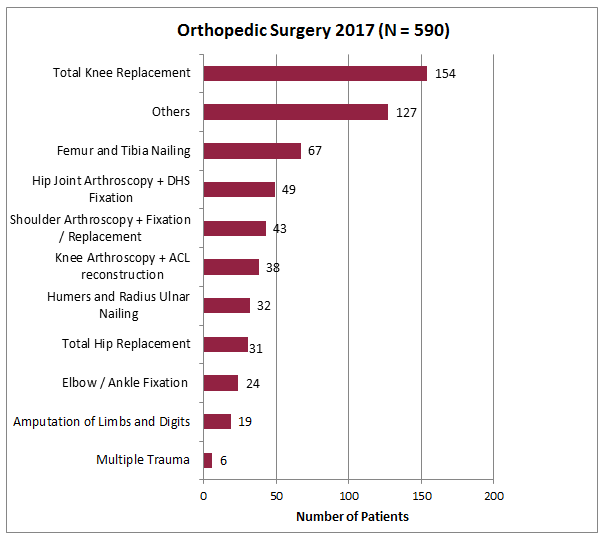ORTHOPEDICS & JOINT REPLACEMENT
Orthopedic surgery at Marengo CIMS Hospital in Ahmedabad is the surgical treatment of diseases and injuries affecting the musculo-skeletal system (the system that enables physically movement using the muscles and skeleton).The aim of orthopedic surgery at Marengo CIMS Hospital in Ahmedabad, therefore, is to restore lost function in any part of the musculo-skeletal system to allow the patient to return to their former way of life. Among the list of specialties, common procedures involve knee surgery, shoulder surgery, hip surgery and hand surgery.
Where possible, the senior and leading orthopedic surgeons at Marengo CIMS Hospital in Ahmedabad use the latest minimally invasive surgical techniques to reduce recovery time. This is especially helpful with knee and back surgery, where the area being operated on is particularly complex and delicate. Marengo CIMS Hospital and its team of the best doctors in Ahmedabad have successfully helped patients as old as 97 years of age and helped them to walk again.
Marengo CIMS Hospital offers the best orrthopedic doctors in Ahmedabad and the top orthopedic surgeons in Rajasthan and Gujarat. We have the best joint replacement surgeons in India.
Our highly experienced orthopaedic team at Marengo CIMS Hospital has expertise in diagnosing and treating various complex orthopaedic disorders, including limb surgery, trauma, bone diseases, and other congenital conditions. In our orthopaedic department, we focus on early mobilisation, minimal discomfort. Our state-of-the-art, specialised facility is designed to provide the highest levels of professional expertise and patient care.
ALL TYPES OF FRACTURE CARE INCLUDING COMPLEX & COMPLICATED FRACTURES
– All ligament injuries & sports injuries
– Advanced shoulder & knee arthroscopy
– Revision of previously failed orthopaedic surgeries
– Cartilage regeneration and repair
– Shoulder, elbow, handsurgery
– Advanced care for Orthopaedic infections
JOINT REPLACEMENT SERVICES
– Partial, Total and Revision Hip and Knee Replacement
– Elbow, Shoulder and Small Joint Replacement Surgeries
– Knee replacement surgeries with TRUE ALIGN TECHNIQUE
For Achieving better precision and accuracy Implants with good track record
ARTHROSCOPY & SPORTS MEDICINE
– Total management of sports injuries
– Cartilage replacement
– Cruciate ligament reconstruction
– Meniscus repair
– Shoulder stabilisation for dislocations
FOOT & ANKLE ORTHOPAEDIC SERVICES
– Flat Foot Correction
– Diabetic Foot Management
– Foot & Ankle Ligament Reconstruction
– Foot & Ankle Trauma
– Foot & Ankle Revision Surgeries
– Sports Injuries related to Foot & Ankle
– Deformity Corrective Foot &Ankle Surgeries
– Foot & Ankle Arthroscopy
ORTHOPAEDIC ONCOLOGY
Treatment for Bone tumors like
– Curettage and Bone Grafting
– Tumor Resection and Arthrodesis
Harsh Vyas
Consultant Foot and Ankle Surgeon
Dr Harsh Vyas M.B.B.S., M.S. Orthopaedics, FIFAS Consultant Foot and...
K.C. Mehta
Director - Orthopaedics & Joint Replacement
Dr. K.C. Mehta MBBS, MS (Orthopaedics) Director – Orthopaedics &...
Neil Rohra
Sr. Consultant Orthopedics & Trauma Surgeon
Dr Neil Rohra M.B.B.S., M.S. (Orthopedics) Fellowship in Joint Replacement...
Pranav Shah
Head of Orthopaedic Trauma Program (Surgeon)
Dr Pranav A. Shah Orthopaedics MS (Ortho), DNB (Ortho), MNAMS...
Prathmesh Jain
Consultant Arthroscopic
Short Profile Dr Prathmesh Jain MS (Orthopaedics) Consultant Arthroscopic &...
Samip C Sheth
Orthopaedic Surgeon
Dr Samip C Sheth Orthopaedics MBBS, D.Ortho, FARCS (ISAKOS) Consultant...
Tirth Vyas
Dr. Tirth Vyas DNB Ortho (Mumbai), MNAMS FISS (USA), FIAS...
Marengo Asia CIMS Hospital in Ahmedabad stands as a beacon of excellence in orthopaedic care, offering a wide range of treatments for musculoskeletal conditions. Equipped with advanced technology, a team of highly experienced orthopaedic surgeons, and a patient-centric approach, Marengo Asia CIMS Hospital provides world-class care that covers everything from joint replacements to minimally invasive surgeries.
Comprehensive Orthopaedic Services
Marengo Asia CIMS Hospital is committed to delivering high-quality orthopaedic care through a multidisciplinary approach. The hospital offers specialized services for various conditions affecting the bones, joints, ligaments, tendons, and muscles. The orthopaedic department is equipped to handle both routine and complex cases, ensuring patients receive comprehensive care tailored to their specific needs.
Key Orthopaedic Procedures at Marengo Asia CIMS Hospital
1. Primary Knee and Hip Replacement Surgeries
Marengo Asia CIMS Hospital is a leader in performing primary knee and hip replacement surgeries. These procedures are recommended for patients suffering from severe arthritis, joint degeneration, or trauma. The hospital’s orthopaedic team uses the latest surgical techniques and advanced implants to ensure patients regain mobility and live pain-free lives. Emphasis is placed on minimally invasive techniques that reduce recovery time, decrease postoperative pain, and enhance the overall outcome.
2. Revision Knee and Hip Replacement Surgeries
For patients who have previously undergone joint replacement surgery and are facing complications or implant failure, Marengo Asia CIMS Hospital offers revision knee and hip replacement surgeries. These surgeries are more complex than primary replacements and require advanced surgical expertise to remove the old implant and replace it with a new one. The hospital’s skilled orthopaedic surgeons specialize in handling such complicated cases, ensuring successful outcomes and long-term relief.
3. Shoulder Replacement Surgeries
Shoulder problems, such as severe arthritis or rotator cuff injuries, can significantly affect a patient’s quality of life. Marengo Asia CIMS Hospital provides shoulder replacement surgeries, which involve replacing the damaged parts of the shoulder joint with prosthetic components. These surgeries help restore function and reduce pain, allowing patients to return to their daily activities with improved shoulder mobility.
4. Elbow Replacement Surgeries
Elbow replacement surgery is often necessary for patients with severe joint damage due to rheumatoid arthritis, fractures, or other conditions. At Marengo Asia CIMS Hospital, elbow replacement surgeries are performed using cutting-edge techniques to replace the damaged elbow joint with an artificial joint, providing pain relief and restoring function.
5. Arthroscopic Surgeries of Knee and Shoulder
Marengo Asia CIMS Hospital is at the forefront of arthroscopic surgeries for the knee and shoulder. These minimally invasive procedures involve small incisions and the use of a camera (arthroscope) to guide the surgery. Arthroscopic techniques are used to treat a variety of conditions, such as torn cartilage, ligament injuries, and joint inflammation. The hospital’s arthroscopic surgery team is adept at performing procedures with precision, reducing recovery times, and minimizing scarring.
6. Repair of Ligament and Meniscal Tears
The hospital specializes in the repair of ligament and meniscal tears, which are common sports injuries. Using minimally invasive arthroscopic techniques, the hospital’s orthopaedic surgeons repair these tears, helping patients recover faster and return to their active lifestyles.
7. Hand Surgery
Marengo Asia CIMS Hospital offers a range of hand surgeries to treat conditions affecting the hand and wrist. The procedures include carpal tunnel release, trigger finger surgery, wrist surgery, replacement of small joints in the hand, and rheumatoid hand and wrist surgery. These surgeries are performed by skilled hand surgeons who use both traditional and minimally invasive techniques to provide relief from pain and restore hand function.
Multidisciplinary Team and State-of-the-Art Technology
The success of orthopaedic surgeries at Marengo Asia CIMS Hospital is attributed to its multidisciplinary team of orthopaedic surgeons, anaesthesiologists, physiotherapists, and pain management specialists. This team collaborates to create personalized treatment plans that address each patient’s unique needs, ensuring optimal recovery and rehabilitation.
The hospital is equipped with state-of-the-art technology, including advanced imaging systems, robotic-assisted surgery tools, and high-precision surgical instruments, which play a crucial role in enhancing surgical accuracy and patient outcomes.
Patient-Centric Approach and Post-Operative Care
Marengo Asia CIMS Hospital is committed to providing a patient-centric approach, ensuring that each patient is well-informed and comfortable throughout their treatment journey. From preoperative counseling to postoperative rehabilitation, the hospital’s orthopaedic team is dedicated to supporting patients every step of the way.
Postoperative care is a vital component of successful orthopaedic surgeries. Marengo Asia CIMS Hospital offers comprehensive rehabilitation programs, including physical therapy and pain management, to help patients recover quickly and regain full function.
Marengo Asia CIMS Hospital in Ahmedabad stands as a premier destination for orthopaedic care, providing a wide range of advanced surgical and non-surgical treatments. With a strong emphasis on using cutting-edge technology, a multidisciplinary approach, and a patient-first philosophy, the hospital continues to set benchmarks in orthopaedic care, ensuring patients receive the highest standard of treatment and recovery.
[ngg src=”galleries” ids=”66″ display=”basic_thumbnail”]
English Videos
[yotuwp type=”videos” id=”a9Q8u72kq6U,GAvfVCqdxTE,rN-8QUYNimE,g1EGXZ7f3GE,B7ssgx1WRCM,3dPM1W51D1A,6bCxZgrzIqI,qMiwC-hP6z0,iQkbvN2lZmA,EeY7nnJc_PQ,CZZmMqLH4qY,ezMYQ2nE9aE,7OmsWlkcTC4,2QirACtaZNk,hTWGFxPc8Zc,JgiBDtbjn6k” ]
Gujarati Videos
[yotuwp type=”videos” id=”V2lFG-afSgs,tjHZZrs6sX4,LErU5iAb8d8,SSX6loM-H2Q,PaPl8Y6ry0g,jQl0-8t9nVE,AOvgSPhs4t8,l1cnTNytSkI,KxJiFBs1Ni4,Mkzl1C6jmVY,sVrfS3hfpy4,zMlJdyH6oxk,1e07vz_Voik,vX8meImUib8,bFrnrjvtH4U,r8KkWPbDx80″ ]
Hindi Videos
[yotuwp type=”videos” id=”vBDsR6MdWtQ,x4vO1I1i8Nc,ec4Yy5BPCIw,wxtdPHuoJxY,zMfLdapwnc0,TuA4VIcvyYc,DecpAD3nZaA,w3D5qMGx0_s,nvqznx1sH7A,A1z0bMp0Ao4,OWOhxrzchnE,1vMLxT0mRmQ,NKoH4A7G6cM,1zhqHqJ5JQ0,0aR4uLHjR9g,4tGpa-q9Ka4″ ]
STATISTICS
[elfsight_team_showcase id=”20″]
EDUCATION
In knee replacement surgery, the damaged parts of the bones making up the knee, which rub together, are removed using highly specialized instruments and replaced with metal and plastic implants.
In total knee replacement surgery, the parts of the bones that rub together are resurfaced with metal and plastic implants. Using special, precision instruments, your surgeon will typically remove the damaged surfaces of all three bones. The replacement surfaces will then be fixed into place.
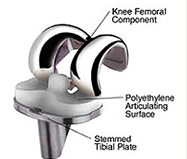
HOW KNEE REPLACEMENT IS DONE ?
Once you are under general anaesthesia or spinal/epidural anaesthesia, an 6 inch cut is made in the front of the knee. The damaged part of the joint is removed from the surface of the bones, and the surfaces are then shaped to hold a metal or plastic artificial joint called Prosthesis. The Prosthesis is attached to the thigh bone, shin and knee cap with cement. When fit together, the attached artificial parts form the joint, relying on the surrounding muscles and ligaments for support and function.
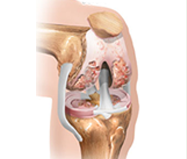
WHY KNEE REPLACEMENT IS DONE ?
Knee Replacement Surgery is recommended for people over the age of 50 with a stiff, painful knee that makes it difficult to perform even the simplest of activities usually due to osteoarthritis, rheumatoid arthritis or traumatic injuries and fractures.
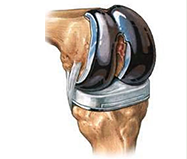
WHAT TO EXPECT BEFORE AND AFTER SURGERY ?
Once you and your surgeon decide that this surgery is right for you, a date will be scheduled for your surgery. Several things may be necessary to prepare for surgery. For example, your surgeon might ask you to have a physical examination by an M.D. physician or your regular doctor. Because blood transfusions are likely to be needed during your surgery, you may want to donate one unit of your own blood or possibly two units if your surgeon feels it is needed. All preparations for surgery should be discussed with your surgeon.
The average hospital stay is usually 4 days for knee replacement surgery. Almost all patients show a dramatic improvement within a month. Most people report a major reduction or no pain in the damaged joint once it is replaced by the artificial joint.
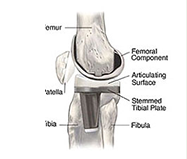
RECOVERY FROM KNEE REPLACEMENT SURGERY
After knee joint replacement, many people are standing and moving the joint a day after the surgery. After about six weeks, most people are walking comfortably with minimal assistance. Once muscle strength is restored, people who have had knee joint replacement surgery can enjoy most activities except running and jumping.
At Marengo CIMS Hospital Ahmedabad, during hip replacement surgery, the painful parts of the damaged hip are replaced with artificial hip parts called prosthesis allowing smooth, nearly frictionless movement.
Hip Replacement Surgery is a surgery that we perform at Marengo CIMS Hospital that restores mobility and reduces pain in patients having damaged hip joints. The damage can be caused by various reasons including osteoarthritis, fractures or tumours.
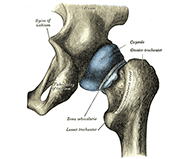
HOW HIP REPLACEMENT IS DONE ?
In total hip replacement surgery, the surgeon at Marengo CIMS Hospital in Ahmedabad uses metal, ceramic, or plastic parts to replace the ball at the upper end of the thigh bone (femur) and resurfaces the hip socket in the pelvic bone. It replaces the damaged cartilage with new joint material in a step-by-step process.
Doctors at Marengo CIMS Hospital Ahmedabad may attach replacement joints to the bones with or without cement.
- Cemented joints are attached to the existing bone with cement, which acts as glue and attaches the artificial joint to the bone.
- Uncemented joints are attached using a porous coating that is designed to allow the bone to adhere to the artificial joint. Over time, new bone grows and fills up the openings in the porous coating, attaching the joint to the bone.
Doctors may use general or regional anaesthesia depending on the general health of the patient.
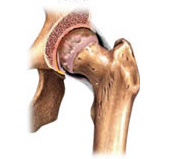
WHY HIP REPLACEMENT IS DONE ?
Doctors recommend hip replacement surgery when hip pain and loss of function become severe and when medicines and other treatments no longer offer any relief from the pain. Hip Replacement Surgery at Marengo CIMS Hospital in Ahmedabad is recommended when:
- you have persistent hip pain that does not respond to other treatments and/or
- mobility in your joint becomes so restricted that day-to-day tasks such as walking are very difficult or impossible
Common causes of Hip pain include:
- Osteoarthritis
- Rheumatoid arthritis
- Hip fractures
- Bone Tumours
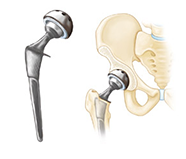
WHAT TO EXPECT BEFORE AND AFTER SURGERY ?
Your doctor at Marengo CIMS Hospital in Ahmedabad may recommend that you take antibiotics before and after the surgery to reduce the risk of infection. If you need any major dental work, your senior doctor may recommend that you have it done before the surgery. Infections can spread from other parts of the body, such as the mouth, to the artificial joint and cause a serious problem.
After the surgery, you will receive antibiotics for another day and pain killers and anticoagulant medication for a few weeks after the surgery at Marengo CIMS Hospital in Ahmedabad.
You may also have a compression pump or compression stocking on your leg, which squeezes your leg to keep the blood circulating and to help prevent blood clots. And you may have a cushion between your legs to keep your new hip in the correct position.
Your may need to do simple breathing exercises to help prevent congestion in your lungs while your activity level is reduced. You may also learn to move your feet up and down to flex your muscles and keep your blood circulating. And you may begin to learn about how to keep your hip in the correct positions while you move in bed and get out of bed.
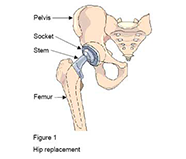
RECOVERY FROM HIP REPLACEMENT SURGERY
Usually, the patient needs a walker, a cane, or crutches for few days after the surgery. In general, most people get out of bed with help on the day of surgery or the next day. A Marengo CIMS Hospital Ahmedabad physiotherapist will teach you how to exercise, walk, and do activities such as dressing and cooking while you allow your hip to heal.
Monitor the surgery site and your general health, after you go home. For a while, you may need to sit only in high chairs (not on low seats that flex your hip more than 90 degrees), use a toilet seat raiser, and sleep on your back.
You will have an exercise program before you leave Marengo CIMS Hospital in Ahmedabad to follow when you go home. You should also take a short walk several times each day. If you notice any soreness, try a cold pack on your hip and perhaps decrease your activity a bit, but don’t stop completely. Staying with your walking and exercise program will help speed your recovery.
Controlling your weight will help your new hip joint last longer. Stay active to help keep your strength, flexibility, and endurance at it’s best. Your activities might include walking, swimming (after your wound is completely healed), dancing, golf (don’t wear shoes with spikes, and do use a golf cart), and bicycling on a stationary bike or on level surfaces. More strenuous activities, such as jogging or tennis, are not advised after a hip replacement.
In shoulder replacement surgery, the damaged parts of the shoulder are removed and replaced with artificial components, called prosthesis.
The shoulder replacement surgery includes replacing the ends of the damaged upper arm bone (humerus) and the shoulder bone (scapula) with artificial surfaces lined with plastic or metal and plastic. Shoulder joint components may be held in place with cement.
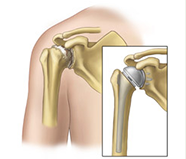
HOW SHOULDER REPLACEMENT IS DONE ?
The top end of your upper arm bone is shaped like a ball. Muscles and ligaments hold this ball against a cup-shaped part of the shoulder bone. Surgeons at Marengo CIMS Hospital Ahmedabad usually replace the top of the upper arm bone with a long metal piece, inserted into your upper arm bone that has a rounded head. If the cup-shaped surface of your shoulder bone that cradles your upper arm bone is also damaged, doctors smooth it and then cap it with a plastic or metal and plastic piece.
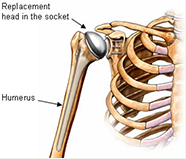
WHY SHOULDER REPLACEMENT IS DONE ?
Following conditions can cause the necessity for a shoulder replacement surgery at Marengo CIMS Hospital Ahmedabad:
- Osteoarthritis (Degenerative Joint Disease)
- Rheumatoid Arthritis
- Post-traumatic Arthritis
- Rotator Cuff Tear Arthropathy
- Avascular Necrosis (Osteonecrosis)
- Severe Fractures
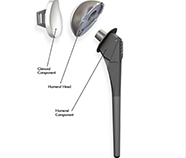
WHAT TO EXPECT BEFORE AND AFTER SURGERY ?
Your doctor at Marengo CIMS Hospital in Ahmedabad may recommend that you take antibiotics before and after the surgery to reduce the risk of infection. If you need any major dental work, your doctor at Marengo CIMS Hospital in Ahmedabad may recommend that you have it done before the surgery. Infections can spread from other parts of the body, such as the mouth, to the artificial joint and cause a serious problem.
You will have intravenous (IV) antibiotics for about a day after surgery. You will also receive medicines to control pain and sometimes anticoagulants.
After the surgery at Marengo CIMS Hospital in Ahmedabad, a bandage is applied on the shoulder and probably a drain to collect fluid and keep it from building up around the shoulder joint. You may have a catheter connected to your bladder, so you don’t have to get out of bed to urinate. You may also have a compression sleeve on your arm. This sleeve squeezes your arm to keep the blood circulating and to help prevent blood clots.
A physiotherapist at Marengo CIMS Hospital in Ahmedabad may begin gentle exercises of your shoulder on the day of surgery or a day after your surgery. These exercises are done to relax your arm and let the physiotherapist move your arm for you.
Most people who have shoulder replacement surgery are able to sit up and get out of bed with some help later on the day of surgery.
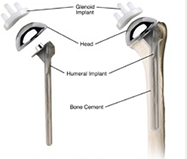
RECOVERY FROM SHOULDER REPLACEMENT SURGERY
Rehabilitation after a shoulder replacement starts right away. It is very important that you do it. The main goal of rehabilitation is to allow you to move your shoulder as far as possible so you can perform daily chores easily. Most people eventually regain normal shoulder motion after 6 to 9 months of surgery. It is very important that you take part in physical therapy both while you are in our hospital and after you are released from the hospital to get the most benefit from your surgery.
Rehabilitation typically continues after you leave the Marengo CIMS Hospital Ahmedabad until you are able to function more independently and you have recovered as much strength, endurance, and mobility in your shoulder as you can.
In elbow replacement surgery, the damaged parts of the humerus and ulna bones are replaced with artificial components made up of a metal and plastic hinge with two metal stems.
Total Elbow Arthroplasty or Elbow Replacement is a surgery that restores mobility and reduces pain in patients having damaged elbow joints. The damage can be from traumatic injury or from a disease like Rheumatoid Arthritis.
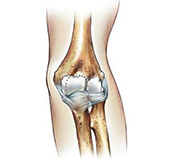
HOW ELBOW REPLACEMENT IS DONE ?
During the elbow replacement surgery, our surgeon at Marengo CIMS Hospital in Ahmedabad removes damaged tissue and parts of the two arm bones, the humerus and the ulna meeting at the elbow joint. Once the tissue and the bone is removed, the elbow joint is replaced with an artificial joint called Prosthesis. The prosthesis consists of two implants that are attached to the insides of the ulna and the humerus. The Prosthesis is joined using a metal and plastic hinge. There are various types of implants available that fit joints of varying sizes. Elbow replacement is relatively uncommon but it is similar to hip and knee replacement.
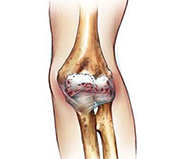
WHY ELBOW REPLACEMENT IS DONE ?
Earlier elbow replacement was carried out for patients whose joints had been severely damaged due to Rheumatoid Arthritis. They are still the most benefitted due to this surgery. In younger and more active people, early failure of the mechanism is much more likely; therefore, it is recommended for people older than 60 years of age.
Other reasons to get elbow replacement done include:
- Arthritis after injury (traumatic arthritis)
- Osteoarthritis
- Acute fractures in the upper or lower arm near the elbow
- Tumors or tumor resection
- Arthritis after previous surgery
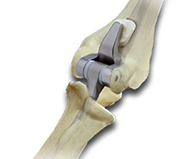
WHAT TO EXPECT BEFORE AND AFTER SURGERY ?
It is strongly recommended to discontinue smoking prior to the surgery. The patient also needs to address any infections and control any other medical problems that he may be suffering from.
The surgeon must be informed of all the existing health issues including allergies, use of prescription and non-prescription medications, alcohol consumption or taking any vitamins or other supplements or any other herbal or homeopathic medicine.
The surgery at Marengo CIMS Hospital in Ahmedabad takes nearly two hours. It is performed under general or nerve block anesthesia. Once our surgeon at Marengo CIMS Hospital in Ahmedabad implants the joint, the wound is closed with stitches and then covered with a bandage.
The arm is usually kept in a splint to keep it stable. Elbow replacement involves cutting skin, tendons, and bone, and so you will be given strong pain medications for one to two weeks after the surgery is done.
You should be prepared to be less functional than usual for six to 12 weeks after elbow replacement.
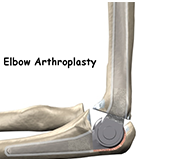
RECOVERY FROM ELBOW REPLACEMENT SURGERY
Simple exercises and other types of physiotherapy will need to be done to increase the strength and mobility of your arm. Typical range-of-motion exercises include bending, straightening, palm down, and palm up exercises.
Elbow replacement usually reduces pain and improves elbow function during sleep and activities of daily living. If you take care of your elbow after surgery and avoid activities that can damage your elbow, you can expect to enjoy the benefits of the surgery for decades.
FAQ
For Plantar Fascitis
What is plantar fascitis?
What are the symptoms of plantar fascitis ?
- Pain at the bottom of the foot near the center of the heel bone
- Pain after standing up from a sitting position after a long time.
- Pain after exercises.
- Pain in the morning(first step pain)
What are the causes of plantar fascitis?
- Females
- Associated with increase in age
- Increase in body weight
- Directly proportional to the increase in hours of standing.
- Wearing of worn out shoes
- Shoes with thin soles
- Flat feet
- High heel shoes
- Tight calf muscle (tendo achilies)
- Abnormal walking pattern (gait)
- Abnormal position of foot while walking.
How to diagnose plantar fascitis?
- For the right diagnosis of the condition,it isbalways better to consult a foot and ankle superspecialist.
- A detailed history and examination done by the doctor would lead to a thorough diagnosis.
- To rule out other causes of heel pain the doctor may advice some tests like xray(rule out fracture),MRI (rule out nerve compressions) or USG(rule out tears).
- The condition normally is supposed to subside by few months of conservative therapy like medication,physical therapy and heel cups.
What is the treatment of plantar fascitis?

Contact Us
Toll Free Number : 1800 309 9999
Medical Helpline +91 70 69 00 00 00
Phone: 079 4805 1200 or 1008
+91 79 2771 2771 or 72
Ambulance: +91 98244 50000
Email: info@cims.org | opd.rec@marengoasia.com | marengocims.info@marengoasia.com
Location
Marengo Asia Healthcare Private Limited
CIN Number - U85100GJ2020PTC131504
Plot No. 67/1, Opp. Panchamrut Bunglows, Nr. Shukan Mall, Off Science City Road, Sola, Ahmedabad – 380 060
In case of any patient safety or quality-of-care related concern, please contact to JCI by clicking here.

